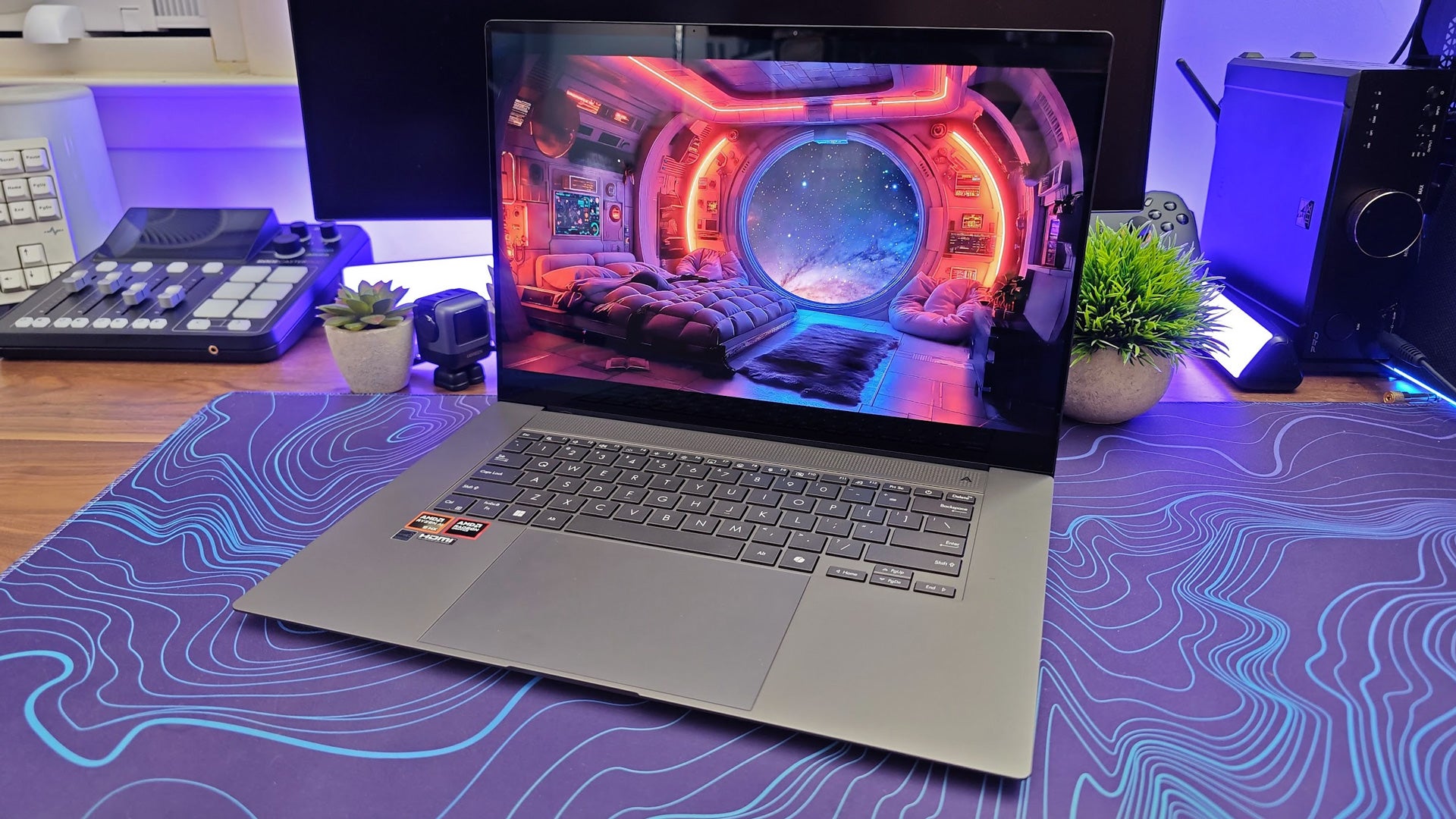With AI taking over the tech world this year, Intel, AMD, and most laptop manufacturers have wasted no time making the most of it. We’ve seen what Intel has to offer with its Core Ultra series and now we can finally see AMD’s answer in the Asus Zenbook S 16. It’s a high-end ultrabook that drips with premium fit and finish, and thanks to a powerful combination of ample memory, a fast SSD, and the AMD Ryzen AI 9 HX 370 processor, it has the performance and battery life to back up its good looks.
Asus Zenbook S 16 Review – Design and Features
For all intents and purposes, the Asus Zenbook S 16 is designed to be a MacBook Pro competitor. It’s thin, light, and has a classy design that’s simple but elegant yet doesn’t hold back on processing power. It has a beautiful OLED display, plenty of connectivity, memory, and storage space. Most importantly, it features AMD’s latest high-end mobile CPU, the Ryzen AI 9 HX 370.
The Zenbook S 16 comes in two configurations. Our sample came with the following specs:
Asus Zenbook S 16 (2024) – Specs
- Display: 16-inch, 2880 x 1800 OLED, 120Hz
- Processor: AMD Ryzen AI 9 HX 370 processor (12C/24T)
- Graphics: AMD Radeon 890M Graphics (Integrated)
- Memory: 32GB LPDDR5X
- Storage: 1TB PCIe 4.0 NVMe
- Networking: Wi-Fi 7 (802.11be 2x2), Bluetooth 5.4
- I/O Ports:
- 1x USB 3.2 Gen 2 Type-A
- 2x USB 4.0 Gen 3 Type-C support display / power delivery
- 1x HDMI 2.1 TMDS
- 1x 3.5mm Combo Audio Jack
- SD 4.0 card reader
- Camera: 1080p, 30 fps, IR
- Battery: 78WHrs
- Dimensions: 13.92" x 9.57" x 0.47" - 0.51"
- Weight: 3.31 lbs
The Zenbook S 16 comes in two versions, an introductory model for $1,399 and the upgraded version we were sent which retails for $1,699. The biggest difference between the two is that the entry level model uses a slightly slower processor, the AMD Ryzen 9 HX 365. Unlike the HX 370 found in the more expensive version, which has 12 cores and 24 threads, the HX 365 only has 10 cores and 20 threads. Its maximum clock speed is also slightly lower at 5GHz instead of the 5.1GHz of the HX 370. System memory is also lower but still ample at 24GB instead of 32GB, but both models feature 1TB of fast NVMe storage.
No matter which you choose, first impressions are impressive. It’s ridiculously thin, measuring only 12mm at the front and 13mm at the back. Despite being slightly larger than most laptops, it’s significantly lighter, weighing only 3.31 pounds. That’s a full pound and a half less than the MacBook Pro 16 and about 3mm thinner.

With such an airy, slim design, it’s exceptionally portable. I’ve loved carrying it through the day. As thin as it is, I had no trouble fitting it into my bag, whether I was carrying a backpack or a messenger bag, I never once felt weighed down. My last laptop, the Asus Zenbook 14 OLED, was even lighter by about a pound, but I could barely tell the difference once it was in my bag. The screen size and larger keyboard are definitely worth the trade-off.
The S 16 features a large 16-inch OLED display that comes calibrated for creative work out of the box. It covers 100% of the DCI-P3 color space and is Pantone certified for accuracy, making it perfect for creative professionals. It’s rated for 500-nits at its peak (I measured it at 487 nits peak and around 350 nits for typical SDR brightness). Here, it falls a little short for use in direct sunlight but it’s very vibrant and color rich. It also uses a glossy panel which looks great but forces you to contend with reflections.

If you’re worried about burn-in, Asus has built in a number of OLED safety features to help keep it at bay. Pixel shifting is on permanently, but you can also enable pixel refresh cycles that engage when the laptop hasn’t been used for 30 minutes, as well as automatic taskbar hiding and transparency. There’s a target mode you can enable, which darkens everything but your current window – but it was still a bit buggy, so I left this off. The software also warns you not to leave static elements on the screen for extended periods of time, so hiding desktop icons and using animated wallpapers are still best practices.
Inside, its HX 370 processor is a step forward from the previous Ryzen 8000 series mobile APUs. It has more cores and threads, a more powerful built-in GPU, and dedicated AI cores for enhanced performance in AI applications. Though the pool of compatible apps is currently limited, it’s inevitably going to be included in more applications going forward, so its utility should increase over time.
Its improved integrated graphics are one of the most exciting parts and one of the biggest reasons why you might want to pay extra for the higher-spec version. The Zenbook S 16 features Radeon 800M series graphics built on the RDNA 3.5 architecture. Depending on which version of the S 16 you choose, you’ll either get the 880M or 890M, the latter coming with the HX 370 version and offering the best performance in an integrated GPU today.
The 800M series is a half-step – a refresh and optimization of the 700M series that is used in most Windows gaming handhelds today. But despite not being a full generational leap, the 890M offers more graphics cores, 16 instead of 12. The 880M doesn’t increase the core count. As you can imagine, the 890M has sparked a fair amount of excitement in the integrated graphics and handheld communities. The 780M was already good for mid-spec gaming and the added cores of the 890M promise even better performance.

Its construction exudes quality. The lid is made of Ceraluminum, a new material that Asus says is a combination of ceramic and aluminum. The texture is smooth and has a granular finish with a minimal, stone-like pattern. The lid is traced with diagonal accents that are etched to reveal gleaming aluminum that catches the light. The laptop comes in dark or light variants. I was sent the dark version, and it looks and feels great. Asus claims this new material is more scratch-resistant and I can see that. It feels robust, and is also more resistant to fingerprints, which is another nice touch.
Opening it up, you’ll find a spacious deck with an exceptionally large touchpad. The touchpad measures 6 x 4 inches and is centered below the keys ensuring that it’s always under your thumb. It uses integrated buttons with full gesture control, and I found it reliable to use. The keyboard is set a little higher up to accommodate its large size, but doesn’t feel awkward at all.
Making the most of its size, Asus has embedded touch sliders into the sides of the touchpad. Sliding up and down on the right adjusts screen brightness while the left adjusts volume and top offers track controls. Pulling down from the right corner also launches ScreenXpert, which can be used to configure two displays. It’s a neat idea, but with the trackpad being so large, I frequently found myself adjusting screen brightness by accident, so I had to turn this feature off. I wish you could turn off individual sliders to keep the embedded media controls – but it’s all or nothing.

The keyboard is quite good. There’s a bit of flex that’s visible when pressed upon because of its exceptionally thin frame, but I didn’t notice it at all when typing. The keys have a 1.1mm travel distance and nice tactility. I was able to transition from my last laptop, the 14-inch Zenbook, seamlessly without losing typing speed or accuracy. It has a white backlight that can be adjusted for brightness, and uses an ambient light sensor to automatically brighten or darken the backlight depending on the amount of light in your room.

There are no dedicated media controls outside of the touchpad but, like most laptops, it has a selection of secondary commands embedded into the function row. You can control screen brightness, keyboard brightness, enable or disable the webcam and microphone, and launch the MyAsus configuration app. The keyboard also has navigation commands built into the arrow keys.

The chassis of the laptop is well ventilated to keep its components cool. There are two large vents, one on the top just above the keyboard and another on the bottom directly below it. The top vent at first looks like any other but on close inspection you can see that every milled hole actually has two smaller milled holes inside of it. It’s a small detail but one that speaks to the fine detail Asus applied to its design.

You’ll also find that it offers expanded connectivity compared to the MacBook Pro and many other ultrabooks. For physical connectivity, it supports two USB4 Type-C ports that both support video and power delivery, one USB 3.2 Gen 2 Type-A port, a full-size SD card reader, an HDMI 2.1 video out, and a 3.5mm combo audio jack.

Wireless connectivity is forward-looking. It supports WiFi 7, which is such a new WiFi protocol that your devices probably don’t even support it yet. It’s capable of 46 Gbps maximum speeds, which is a massive uptick from the 9.6 Gbps of WiFi 6E. If you don’t have a WiFi 7 router yet, don’t worry. It’s backwards compatible. It also supports Bluetooth 5.4 for a reliable, low energy connection.
The speakers in the laptop are surprisingly good. Despite being so thin, they can get loud and then louder still if you opt for Extra Volume in the MyAsus software. They offer a decent amount of bass too, though still sound thin in comparison to a good pair of speakers or gaming headset. Still, for streaming, they work better than many even more expensive laptops I’ve tested.
Finally, the S 16 supports a 1080p webcam that can record up to 30 fps and supports Windows Hello facial recognition. I found it to be color accurate and handled background lighting surprisingly well. Some details, like my facial hair, were a little bit soft, but overall it offers good clarity and vocal pick-up from its mics. Biometric login was also the most reliable I’ve found on a laptop yet. Essentially, as long as its IR sensor could see my eyes, it worked, glasses or no glasses.
Asus Zenbook S 16 Review – Software
The Zenbook S 16 uses the MyAsus app for configuration, troubleshooting, registration and warranty access, and keeping the laptop up to date. It’s a far cry from most gaming software suites I’ve seen, even Asus’s own Armoury Crate, but it provides you with all of the options you would expect. Just don’t go looking for fancy lighting effects or recording macros to the keyboard because those options are nowhere to be found.
The Zenbook S 16 is a productivity and creation laptop and the options are presented a bit more simply as a result. It gives you access to just about everything you’ll need, from performance mode (fan profile), to the presentation of the screen, to EQ and volume, and even the pickup pattern of the microphone. It is fairly full-featured with plenty of options for just about everything short of overclocking.

One feature I especially liked is its ability to diagnose different problems you may encounter. You can either run a whole system diagnostic, break it down into specific components, or simply choose a common problem you may be experiencing. My system didn’t have any issues during testing to experience how accurate and effective it may be, but it’s the kind of consumer-friendly feature that could be very helpful for users that are less tech savvy.
Asus Zenbook S 16 Review – Performance
The Zenbook S 16 is a fantastic laptop with plenty of power for most applications. It can even handle some gaming if you don’t mind turning down some settings and playing at a lower resolution. The Ryzen 9 HX 370 processor does the work, even if its AI features really don’t come into play most of the time, and does so consuming less power than many competing high performance processors. In its highest performance mode, it runs at a maximum of 33W. The chip itself is specced up to a 54W by AMD, so Asus made a deliberate decision to keep the power draw lower for quieter performance and longer battery life. It’s likely that we’ll see other laptops using this chip that fully leverage its TDP and push performance even higher.
To test the performance of the laptop, I ran it through our usual sequence of synthetic tests and real world gaming benchmarks. Since most of what we test here are gaming laptops with dedicated GPUs, the comparison here isn’t 1:1 with most of the competitors we’ve benchmarked. In comparison, I chose the recent Samsung Galaxy Book 4 and another recent thin and light laptop with a similar AMD chip, the Asus TUF Gaming A14.
A couple of salient points before taking a closer look at gaming. First, the PCMark 10 benchmark. This is a whole system test that leans heavily on the processor. The S 16 is exceptionally close, near the margin of error, to the Asus TUF Gaming 14 despite using about 25% less power. Compared to the Galaxy Book 4, running Qualcomm’s new Snapdragon CPU, it outperforms it in all but battery life. But, as is clear from the many instances of programs not running, compatibility is still leagues better on a dedicated x86 processor.

For gaming performance, I chose to compare it with several of the gaming handhelds out today. While they’re different form factors, the specs on many of these handhelds are quite competitive with the S 16. Since they’re essentially just tiny laptops with a gamepad instead of a keyboard, and expectations of their performance are more widely understood, the comparison is apt. Not to mention, this gives us a peek into what kind of performance we can expect from handhelds using the HX 370 in the future.
All of our gaming tests are conducted at max settings, including ray tracing, with FSR on Balanced mode. This provides a useful basis for comparing relative performance but it isn’t how you should expect to play most games. At 1600p ultra settings, frame rates are mostly too low to be playable. At 1200p, the 16:10 equivalent of 1080p, they become more so. Hitman 3 even manages to average 60 fps.
Still, the gains are a bit closer than I was hoping. In fact, they’re close enough that you could say the performance is close to the same for gaming. But, for an ultrabook, these results indicate that the HX 370 is capable of gaming by trading off some graphics features. They’re also exciting for laptops and handhelds that are able to dial up the wattage to achieve even better performance.
Realistically speaking, you’ll want to adjust these settings to achieve the best frame rates and turn on AMD’s Fluid Motion Frames (FMF) whenever it makes sense to do so. You should also plan on playing at 1200p, which still looks good on this display. Like anything with integrated graphics, you have to find the balance between visual and frame rate.

Cyberpunk 2077 might not be playable at Ray Tracing: Ultra, but dropping to Medium boosted that to 44 fps. Turning on FMF bumped that to 50 to 69 depending on how busy the scene was. Hitman 3 ranged from 84 to 120 with Fluid Motion Frames. Total War: Warhammer III was able to achieve 43 fps on low. Performance can be bumped further by dropping the resolution another step to 1680 x 1050, though the image does become softer and I wouldn’t recommend it without adding image sharpening from the AMD Radeon software.
The S 16 is also a great machine for cloud gaming. Its processor is powerful enough, and its wireless networking fast enough, to support the highest tiers of GeForce Now. I spent many an evening playing Baldur’s Gate over the cloud and finishing up my playthrough of Still Wakes the Deep on Xbox Cloud Gaming. These services worked flawlessly with the S 16.
For day to day use, it worked very well. It started up quickly and ran smoothly for all of my productivity. This included Google Sheets and Google Docs, as well as the Microsoft Office suite. The large touchpad was especially nice for quick navigation. Browsing different websites and managing emails were also seamless and hitch free.
The battery life is also good, though isn’t quite as impressive as I had hoped. In the Procyon Office Battery test, it lasted 13 hours and 37 minutes. In normal use throughout the day, allowing it to turn off the display when I was inactive, I found that it lasted about 11 hours on average. The included charger isn’t bulky at all, however, so I didn’t have any issue plugging it in when it started to run short on the second work day.

The system runs very quietly. Even when its fans are on full blast, it produces a fraction of the sound a typical gaming laptop does. It’s audible but didn’t bother my wife on the other end of the couch as I enjoyed some evening gaming.
The biggest issue is that the chassis can get uncomfortably hot. Both vent areas became so warm that I avoided touching them wherever possible. This wasn’t an issue in the Standard or Whisper modes, but for playing games with higher performance settings or running intensive tasks like longer 4K video renders, I learned to have something else on my lap underneath it, or to just use a desk.
The final thing to note is just how capable it was for creative work. I do a lot of photo editing for my job and edit a fair amount of 4K video. Working in Adobe Photoshop was seamless, even when adding multiple layers and integrating AI fills and neural filters. Rendering videos in Premiere Pro was also fast, though the MacBook Pro certainly wins out with lowering rendering times. Still, renders were quicker than I expected without a dedicated GPU to accelerate the process and didn’t leave me feeling handicapped compared to my beefier desktop PC.






